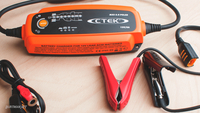Batteries: What Type And Why?

Updated:

A major component of your solar system that determines how much power you can use at any given time is your solar battery.

Unless you have a specific reason not to, you will be looking for a deep cycle battery to power your living area. Deep cycle batteries are designed to provide constant power over long periods and can be discharged quite generously without sustaining damage, whereas starter (aka cranking) batteries are designed to provide a huge amount of power for a very short period (a couple of seconds) in order to start the engine. Deeply discharging a cranking battery can kill it dead.
But cranking batteries aside, there are a few options that are commonly used in solar systems for vans, boats, garages and other small spaces, and you should be aware of them all before making a purchase, as the wrong battery can cost you a lot of money and not provide for your needs as well as you would like. So here are the most common deep cycle batteries you need to know about (note that solar systems for houses are typically much larger and more expensive, and won't be covered here).
Flooded Vs. Sealed
Flooded Cell Lead Acid (FCLA) batteries have 6 screw caps on the top which can be removed in order to top up the electrolytic fluid, which is required from time to time, as the processes that create energy use up the electrolyte and produce hydrogen. These batteries are vented to release gas when the pressure gets high enough, preventing explosion. That means they need to be stored in a ventilated place and you need to monitor the fluid level and top-up as necessary. FCLA batteries must be kept upright to prevent spillage of the highly corrosive and explosive acid electrolyte, and they cannot tolerate too much shock. Although they do have some benefits, including their price point, these drawbacks are enough to rule them out for the purposes of portable solar systems, in my opinion.
Sealed batteries, on the other hand, do away with all of these problems, as the electrolyte is stored in semi-solid gel form that can't be spilled and doesn't produce a gas. Instead, the internal processes are a self-contained cycle, so the electrolyte never runs out. Sealed Lead Acid (SLA / "Maintenance Free") batteries can be stored and used in almost any position and do not require any maintenance, as the name suggests.
But even in the SLA category, there are different battery types.
Gel
All of the above describes a Gel battery, but there are some down-sides. Gel batteries cost more than FCLA and they are sensitive to over-charging, which causes permanent damage. Therefore, it's necessary to buy a t:
 Smart Battery Charger to maintain your Gel battery properly.
Smart Battery Charger to maintain your Gel battery properly. AGM (Absorbed Glass Mat)
Although similar to Gel in many ways, AGM has a few extra benefits. For one, AGM batteries can be used to start your engine, which Gel cannot, making an excellent backup battery in case your cranking battery gets too cold to do the job. AGM batteries can tolerate cold more easily than FCLA, so it could happen. Although charging voltages are a bit higher in AGM than in FCLA, AGM batteries tolerate over-charging a little better, but a dedicated SMART charger is still recommended for maximum care. AGM batteries also charge more rapidly than Gel, making them perfectly suited to the unpredictable charging and discharging that van-life presents. You can't always rely on the sun and you may sometimes need to use more power than expected when the battery is not fully charged. AGM can tolerate a bit more abuse without damage.
However, to fully charge your AGM battery from your solar panel, you will need to invest a little more in your charge controller, as those that don't support AGM charging modes cannot fully charge AGM, and the life span of the battery can be shortened by never being fully charged. Because of their popularity, AGM batteries tend to be cheaper than Gel, despite enjoying several advantages. AGM batteries can be discharged safely to around 70%, but you should avoid doing it too often, as it can shorten the life span of the unit.
LiFePO4 (Lithium Iron Phosphate / Lithium Ferrophosphate)
LiFePO4 are the most expensive choice in this list, but that doesn't make them the best. While they do have some benefits over the other chemistries in this list, they do not have a long history and so far, they don't appear to last a very long time. Additionally, these batteries contain some very rare minerals which requires extra-destructive deep mining. There are many moral issues involved with these batteries, but they do not belong in this article.
LiFePO4 batteries can be discharged as far as 90%, by some estimations, and are significantly lighter than all the types listed above. LiFePO4 batteries are particularly well suited to high loads, as they don't suffer as a result of Peukert's Law, which all the other types do.
If your build is fairly standard, the info above should help you to decide which battery is right for you, but if you have special requirements, I recommend to seek the advice of an expert.
Once you have chosen a battery chemistry, have a look at ![]() Charging Options For Different Battery Types, to find out what kind of charging options there are for each kind of battery.
Charging Options For Different Battery Types, to find out what kind of charging options there are for each kind of battery.
Sign In To Leave A Comment
There are no comments marked as public for this item.
Stay Up To Date





 Power & Water
Power & Water Read around 3,100 times
Read around 3,100 times For Everyone
For Everyone